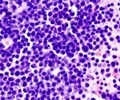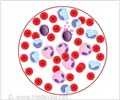A new study finds that survivors of acute lymphoblastic leukemia have a significantly increased risk of secondary cancers when compared to the general population.
Acute lymphoblastic leukemia is the most common cancer in children and adolescents, with almost 4,000 new cases diagnosed in the United States each year. It is also one of the most curable pediatric cancers: survival rates for patients who receive contemporary treatments now exceed 80 percent, and most of these survivors are cured (no evidence of disease for at least 10 years).'Accordingly, characterization of long-term outcomes in acute lymphoblastic leukemia patients who remain in first complete remission for at least a decade has assumed increasing importance, especially in view of the long life expectancy of this survivor population.' But little is known about the incidence of secondary tumors or cancer after 15 to 20 years in children and adolescents who were treated for acute lymphoblastic leukemia.
Nobuko Hijiya, M.D., of St. Jude Children's Research Hospital, Memphis, Tenn., and colleagues conducted a study to estimate the long-term (30-year) cumulative incidence of secondary neoplasms (cancers) in 2,169 children and adolescents treated for acute lymphoblastic leukemia between 1962 and 1998 at St. Jude Children's Research Hospital. The patients had achieved complete remission and had a median (mid-point) follow-up time of 18.7 years (range, 2.4 - 41.3 years).
The researchers found that among the 1,290 patients who remained in complete remission, 123 (9.5 percent) developed a secondary neoplasm as their first event. The cumulative incidence of secondary neoplasms in all patients as the first event after complete remission was 4.17 percent at 15 years, increasing to 5.37 percent at 20 years and to 10.85 percent at 30 years. 'The relatively rapid increase in incidence at 20 years after complete remission can be attributed largely to the late development of meningiomas [a tumor near the brain and spinal cord] and basal cell carcinomas,' the authors write. When meningiomas and basal cell carcinomas were excluded, the overall cumulative incidence was 3.99 percent at 15 years and 6.27 percent at 30 years, representing a 13.5-fold increase in overall risk compared with the general population.
The cumulative incidence of each tumor type at 30 years was 2.19 percent for myeloid (related to bone marrow) malignancy, 0.17 percent for lymphoma, 3.00 percent for brain tumor, 4.91 percent for carcinoma, and 0.57 percent for sarcoma.
'In conclusion, the cumulative incidence of secondary neoplasm after treatment for childhood acute lymphoblastic leukemia does not attain a plateau at 15 to 20 years but continues to increase over 30 years. Although the majority of these late-occurring secondary neoplasms are low-grade tumors such as meningioma and basal cell carcinoma, the health care issues they raise may be critical. The risk for high-grade tumors, especially carcinomas, significantly exceeds the risk in the general population, underscoring the need for continued careful follow-up of acute lymphoblastic leukemia survivors,' the authors write.
Advertisement
PRI/S









